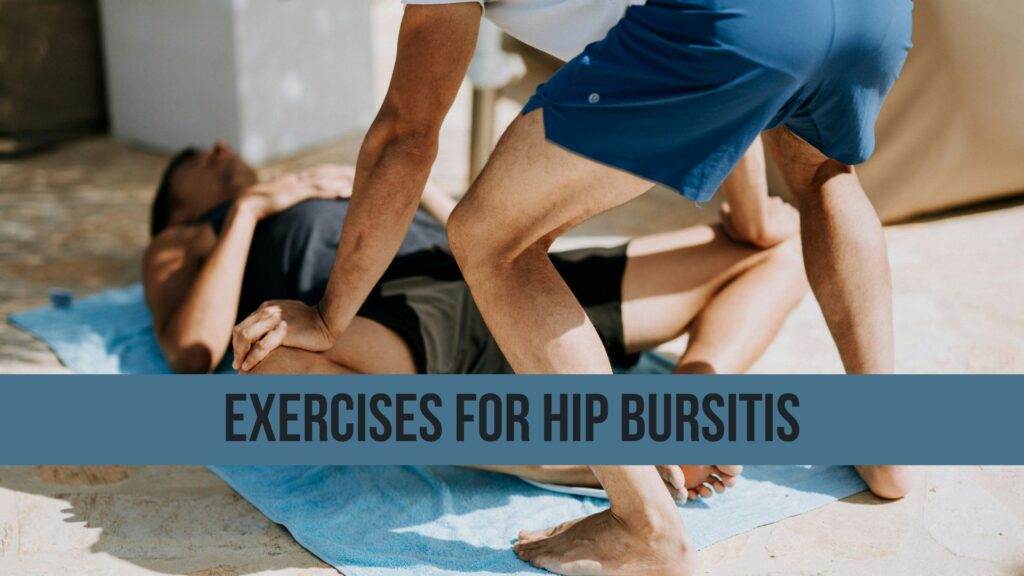If you are suffering from hip bursitis, you know how painful and debilitating it can be. Hip bursitis is a common condition that causes inflammation of the bursa sacs in the hip joint. This can result in pain, swelling, and limited range of motion. Fortunately, there are exercises that can help alleviate the symptoms of hip bursitis and improve your mobility. In this comprehensive guide, we will discuss the top 5 exercises for hip bursitis that can help you on your road to recovery.
Understanding Hip Bursitis
Hip bursitis manifests when the bursa, small sacs filled with fluid that cushion the hip joint, become inflamed. This inflammation leads to discomfort and pain in the hip area, significantly impacting one’s daily activities and quality of life. The role of the bursa is crucial as it helps in reducing friction where muscles and tendons glide over bone. However, when these sacs are inflamed, the smooth movements become painful, leading to the symptoms commonly associated with this condition.
Individuals with hip bursitis often report experiencing pain that radiates on the outside of the hip, which can extend to the thigh area. The pain typically worsens with prolonged standing, climbing stairs, or after prolonged sitting with legs crossed. Besides pain, other indicators include swelling, tenderness upon touch, and a noticeable reduction in hip mobility which can affect walking patterns.
The reasons behind the development of hip bursitis are varied. Repetitive activities that put stress on the hip, such as running or bicycling, are common culprits. Likewise, an injury to the hip or surrounding areas can initiate the condition. In some cases, incorrect posture or previous surgeries around the hip can lead to bursitis. Age also plays a role, with the condition being more prevalent in middle-aged or older adults.
Addressing hip bursitis effectively involves a combination of rest, avoiding activities that exacerbate the symptoms, and engaging in targeted exercises designed to strengthen the muscles around the hip and improve flexibility. Implementing these exercises as part of a rehabilitation program can significantly help in managing the symptoms of hip bursitis and enhance overall hip function, leading to a gradual return to normal activities without the hindrance of pain and discomfort.
Ice to the Outside of the Hip
Applying cold therapy to the hip region is a time-tested method for alleviating the symptoms of hip bursitis. This simple yet effective approach helps in curtailing inflammation and numbing the area to dull the pain. Initiating this treatment involves using a cold compress or an ice pack. If neither is available, a household alternative such as a bag of frozen vegetables can serve as an effective substitute. It’s critical, however, to ensure that the ice or cold pack is enveloped in a protective layer, like a soft towel or cloth, to shield the skin from direct contact with extreme cold, which could potentially cause frostbite or ice burn.
For optimal results, the ice should be applied to the outer hip area, directly over the site of pain and discomfort. Keeping the ice in place for periods of 15 to 20 minutes has been shown to be most beneficial. This duration allows for adequate exposure to the cold, which can significantly reduce swelling without risking damage to the skin and underlying tissues from overexposure to cold temperatures. Importantly, this process can be repeated several times throughout the day, especially after engaging in any activity that exacerbates the pain associated with hip bursitis.
This method of applying ice not only serves to manage the immediate discomfort but also contributes to the longer-term healing process by reducing inflammation around the bursa. It’s a crucial first step in a comprehensive approach to treating hip bursitis, setting the stage for the effectiveness of subsequent exercises and stretches designed to address this condition. Incorporating this practice into the broader context of hip bursitis management can expedite the recovery process, allowing for a smoother transition to more active forms of rehabilitation and ultimately, a return to pain-free movement.
Glute Stretch Lying Down
This stretch is specifically designed to target the glutes, which are pivotal in managing hip bursitis due to their role in supporting hip movement and stability. Initiating this exercise, you should start by positioning yourself on your back on a comfortable, flat surface. This could be a yoga mat or even your bed if getting down to the floor is challenging.
With your spine in a neutral position, bend your knees so that your feet are firmly planted on the ground, hip-width apart. This starting position ensures that your lower back is supported, reducing the risk of strain as you move into the stretch. Next, carefully lift your right foot and place it across your left knee, creating a figure-four shape with your legs. This positioning is crucial as it prepares your hip and gluteal muscles for a deep stretch.
Gently grasp your left thigh with both hands, ensuring that your fingers are interlocked for a firm hold. Now, with a smooth, controlled motion, pull your left knee closer to your chest. You should feel a stretching sensation in the gluteal muscles of your right side. It’s important to proceed slowly and stop at the point of mild tension in the muscles; the goal is to stretch without causing pain.
Maintain this position for about 30 seconds, allowing your muscles to relax and stretch out. The duration is essential for achieving an effective stretch while ensuring that the muscles are not overworked. After holding, carefully release your leg back to the starting position and repeat the process on the opposite side. This bilateral approach ensures that both sides of your glutes are evenly stretched, promoting balance and symmetry in muscle flexibility, which is beneficial for managing symptoms of hip bursitis and improving overall hip function.
Glute Stretch with Leg Crossed
To begin the glute stretch with leg crossed, start by finding a comfortable spot on the floor where you can sit with your legs extended straight out in front of you. This exercise targets the gluteal muscles, which are key in supporting the hip and can contribute to reducing the discomfort associated with hip bursitis. Next, bend your right knee and place your right foot on the floor, ensuring it is next to your left knee. This action initiates the stretch that focuses on the glute muscles and the hip.
As you maintain this position, turn your torso gently to the right. Achieve this by placing your left elbow against the outside of your right knee. Use your elbow as a pivot to deepen the stretch, pressing lightly against your knee as you twist your upper body further to the right. You should feel a stretching sensation in your gluteal muscles and along the outer hip. Be cautious to keep the stretch within a comfortable range; the objective is to relieve tension without inducing pain.
Must Read: Meniscus Tear: Exploring the Benefits of Squats, Heel Raises, and Hamstring Curls
Hold this position for about 30 seconds, breathing deeply to help your muscles relax more into the stretch. Deep, steady breaths can enhance the stretch’s effectiveness by promoting relaxation and increasing the stretch in the targeted muscles. After completing the stretch on one side, gently release and return to your starting position with legs extended. Repeat the process by crossing your left leg over your right, this time twisting your torso to the left to ensure both sides of your glutes are equally stretched. This exercise not only aids in managing symptoms of hip bursitis but also contributes to overall hip mobility and muscle balance.
ITB Stretch
To perform an effective ITB stretch, essential for those dealing with hip bursitis, begin by positioning yourself upright with your legs about hip-width apart. The ITB, or iliotibial band, plays a significant role in hip stability and can be a source of irritation when tight. This stretch aims to alleviate such tension.
Proceed by stepping your right foot behind your left, ensuring that your feet remain flat on the ground. This initial step sets the foundation for a deep stretch along the outside of your thigh, where the ITB is located. Gradually lean into your left side, extending your right arm above your head to intensify the stretch. It’s important to feel a gentle pulling sensation along the right side of your body, from the hip to the lower back and extending down the leg.
Maintain this stretch for approximately 30 seconds, focusing on breathing deeply to encourage muscle relaxation. The deep breathing technique aids in maximizing the stretch’s benefits, allowing for a more profound release of tension within the ITB. After completing the stretch on one side, slowly come back to a standing position and repeat the process on the opposite side. Crossing your left leg behind your right this time and leaning to your right side will ensure that both sides of the ITB are adequately stretched.
This targeted approach not only helps in managing the discomfort associated with hip bursitis but also enhances flexibility and range of motion in the hip area. Incorporating this stretch into your daily routine can significantly contribute to alleviating the symptoms of hip bursitis and promoting a healthier, more balanced hip function.



